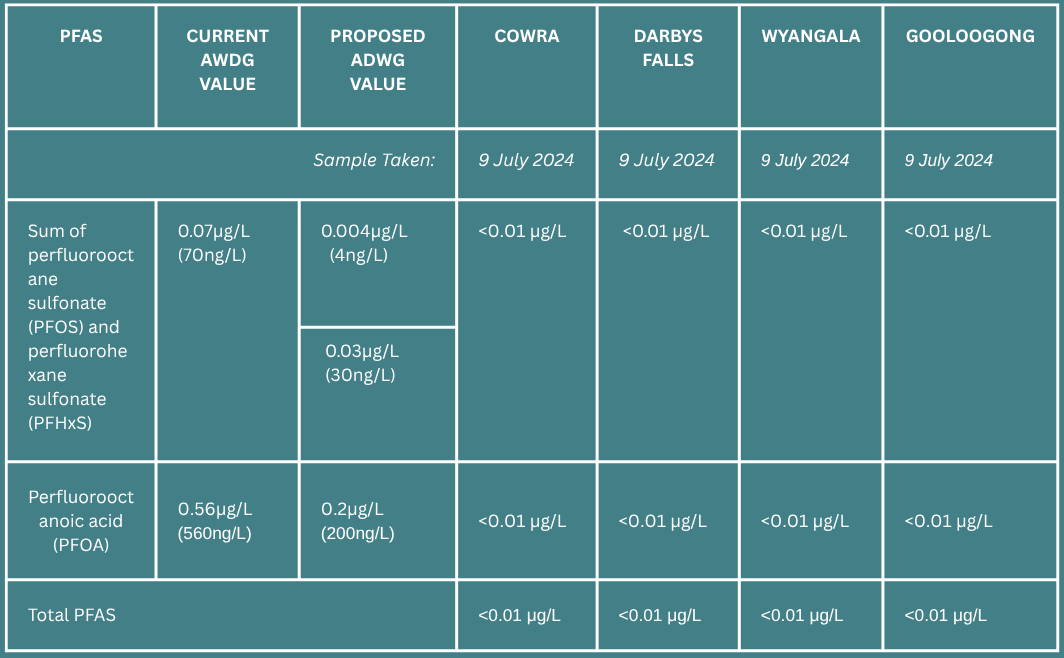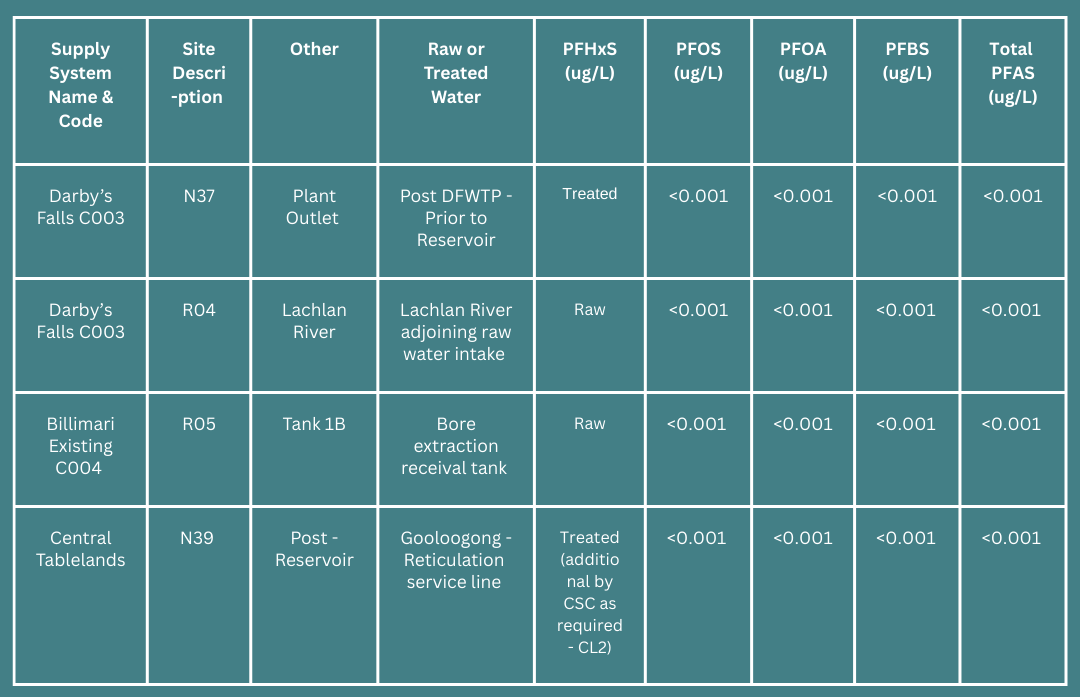Water and Sewage
Water
Council is committed to providing safe and secure water to the people of Cowra and surrounds. Our water network comprises of five water supply systems:
- Cowra (including Woodstock, Westville, Noonbinna, Wattamondara, *Koorawatha, **Greenthorpe, **Brundah, *Bendick Murrell and *Wirrimah):
- Darbys Falls
- Central Tablelands Water (being Gooloogong, Trunk Main H and Pearce's Scheme);
- Wyangala ('non-potable'); and
| *Located within the Hilltops Local Government Area
|
**Located within the Weddin Local Government Area |
The NSW Public Health Act 2010 (the Act) was passed by the NSW Parliament at the end of 2010. The Act (and its supporting Regulations) includes the requirement for water suppliers, such as Council, to produce a Risk-Based Drinking Water Management System (DWMS). The DWMS is to be based on the Australian Drinking Water Guidelines.
DWMS-Cowra-Annual-Report-2023-24.pdf(PDF, 8MB)
DWMS-Annual-Report-2024-25-Cowra-Shire-Council-1.pdf(PDF, 6MB)
PFAS
Council has completed testing for PFAS/PFOS across its potable water supply systems. A summary of these results is as follows:




The Australian Government’s National Health and Medical Research Council (NHMRC) released a revision of the Australian Drinking Water Guideline (ADWG) in June 2025. The revised guidelines included both a reduction and introduction of new health-based guideline values for PFAS chemicals.
PFAS (per and polyfluoroalkyl substances) are a group of human-made chemicals that have been widely used in industrial and consumer products since the mid-1900s. PFAS are of concern as they do not break down easily and can persist for a long time in the environment.
PFAS were used historically in fire-fighting foams which has resulted in increased levels of PFAS being detected at sites such as airports, defence/military bases and/or areas where fire-fighting training or fire suppression has occurred. Historic PFAS use areas are currently being monitored by the NSW Environmental Protection Authority (The NSW Government PFAS Investigation Program). These areas do not include the Cowra or its water supply catchment. The Australian Government has worked since 2002 to reduce the use of certain PFAS.
What are PFAS? AUS GOV PFAS TASKFORCE
Sewer
Council operates two sewage conventional sewerage systems with intermittently decanted extended aeration (IDEA) sewage treatment plants (STPs) in:
Council treats sewerage for discharge (waste water) to the environment in accordance with the individual STP’s Environmental Protection Licences which are issued by the NSW Environmental Protection Authority (EPA).
For more information on Pollution Management Plans for the WTP and STP facilities governed by Environmental Protection Licences Click here.
Water leaks and Meters :
Water leaks
Water leaks on public land
To report a water leak on public land, e.g. a burst water main, please call (02) 6340 2070 during business hours.
For after hours emergencies, including water/sewer breaks, please call0419 219 231.
Detecting water leaks on private property
Property owners are responsible for the repair of any leaks in their homes and businesses and private supply pipes (the pipe from the Council water service to the house and out-buildings like garages and sleepouts).
This means that all water that passes through the water meter will become part of your costs.
Leaking toilets, taps and more particularly, leaking underground pipes can waste a lot of water, leading to high water bills. For example, a tap that drips once every second will waste up to 33 litres per day. In comparison, a leaking underground water pipe can waste thousands of litres per day and not be visible.
Checking for leaks regularly and repairing them quickly is a simple way to save water and money.
Checking for leaks
Household water leaks usually come in two forms, slow or large. A slow leak could be from a fixture – toilet, shower or tap. A large leak could be from the hot water cylinder or leaking pipes.
To check for leaks, please follow these steps:
- Turn off all taps and water using appliances in and around your premises.
- Check your water meter and take a meter reading. If the dials on your water meter are moving there could be a leak. If there is no movement on the dials, there may still be a slow leak.
- To check further for leaks, do not use any water for at least one hour, then take another reading. If the meter reading has changed, there may be a slow leak.
- To fix the leak, check all fixtures and fittings and/or call a licensed plumber.
Sometimes visual clues can help find the location of a leak outside the building, such as green grass patches when other areas are looking brown. Inside a building you may see brown spots or mould that could indicate a slow leak inside the walls/roof. However, if pipes are installed in sandy ground, the leaks can be much harder to detect without appropriate technology for leak detection.
Early leak detection will assist in saving costs for repairs and reduce water loss. As water consumers, we can all play our part in looking for leaks.
Water in your meter?
Sometimes you may notice some water in your water meter. Condensation does occur inside the plastic box, but this doesn’t necessarily mean there’s a leak. There may be a leak if water at the bottom of the box is over a centimetre, and its moving. Contact Council if you’re concerned.
Your Water Meter Explained
Water meters are generally installed on the property boundary, where practical and in a position allowing access to the meter for reading, replacing and repairing the meter. For units, rural or commercial properties, this may not be the case. The location of the water meter is at Council’s discretion and must only be installed by Council employees or Council approved contractors.
A person must not connect in any way to Councils water supply system without the approval of Council.
Inaccessible water meters
Council needs access to water meters for various reasons including reading the meter and repair or replacement. It is important a water meter is not:
- Buried or with insufficient clearance to pipes
- Encased in concrete
- Behind a locked gate or door
- Obscured by an overgrown garden
- In the same proximity as a dog.
Water meters and water pipes leading from the mains to the meter are the property of Council. Customers are responsible for all water that has passed through the meter and the maintenance and repairs of all water services installed after the water meter.
The water meter is read by Council contracted meter readers three times a year. Water that has passed through the meter since the last reading will be billed to the property owner. All meters will have dials showing the amount of water that has been consumed since the meter was installed. These dials are coloured black and red and range from six to nine dials depending on the size and make of your meter.
Reading your water meter regularly can identify any changes in the amount of water being used. Finding a problem early can reduce the impact on the water usage account. The water meter is generally located at the front of the property and it records water usage in kilolitres, which is per thousand litres. If the dials are moving water is passing through the meter.
By keeping a record of your own water use for different water-based activities, you can determine how much water you use every time you do a load a washing or put the dishwasher on. Keep a daily record and multiply the amount by seven (7) and you will have a weekly indication of how much water you use just on these activities.